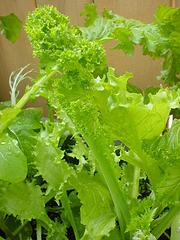Salad Greens
| Infobox on Salad Greens | |
|---|---|
| Example of Salad Greens |  |
| Freshness facts | |
| Optimum carrying temperature | 0°C to 2°C |
| Highest freezing point | - |
| Acceptable product temp. at loading into containers | Max. 2°C above carrying temperature |
| Optimum humidity | 95% to 100% |
| Ventilation setting for containers | 50 m³/hr |
| Storage life | 1-2 weeks (see text) |
| Climacteric / non-climacteric | Non-climacteric |
| Ethylene production | Low |
| Ethylene sensitivity | High |
| Modified / controlled atmosphere | See text |
| Potential benefits | See text |
| Availability | |
| On demand | |
Salad Greens
Contents
Harvesting and Handling
Various greens other than lettuces are used in raw salads. These include, but are not limited to: corn salad, lamb’s lettuce, field salad, rocket salad, roquette, arugula, rucola and rugula. Greens used in raw salads must be fresh, tender and turgid, with no yellowing, decay, or insect or mechanical damage. Whole plants of rocket and lamb’s lettuce are sometimes sold with roots attached, which lengthens postharvest life.
Greens are harvested as individual leaves, leaf clusters, or whole plants and should be young, tender and mild flavoured. Plants that have flowered are usually too strong in flavour and tough in texture for use in raw salads. Salad greens may be packed in fibreboard cartons lined with perforated polyethylene bags, small sealed plastic bags, trays or clamshell containers. These greens may also be packed as bunches of leaves or plants. Due to the delicate texture of the leaves, they are high susceptible to mechanical damage, which may result in discolouration and decay.
Cooling and Storage
Greens for salads should be cooled to 0°C as soon as possible after harvest. Vacuum-cooling is effective for removing field heat. Salad greens should be stored at 0°C to 2°C with 95% to 100% RH. Rocket salad typically lasts 7 to 10 days and other leafy greens 10 to 14 days.
Low temperatures must be maintained throughout the cold chain to minimize pathological disorders and prolong shelf-life. Salad greens are typically susceptible to the same bacterial soft rot and fungal decay as lettuce. Salad greens are not sensitive to chilling and should be stored as cold as possible without freezing.
Controlled atmosphere considerations
CA is generally not beneficial. MAP is mostly beneficial for controlling RH. Salad greens have very low ethylene production, but are highly sensitive to ethylene exposure, which typically results in loss of chlorophyll leading to yellowing of leaves.
Storage disorders
Alternaria rot, Anthracnose, Bacterial rots, Bacterial soft rot, Bacterial spot, Brown rib, Chilling injury, Downy mildew, Freezing injury, Pink rib, Powdery mildew, Rhizoctonia rot











